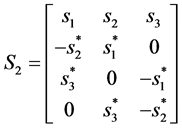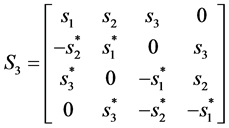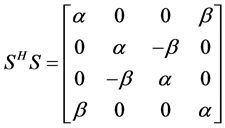A New Scheme to Construct Orthogonal Channel Matrix for MIMO STBC by Givens Rotation ()
Received 3 July 2015; accepted 23 February 2016; published 26 February 2016

1. Introduction
Because of its efficient maximum likelihood decoding, MIMO (Multiple-Input Multiple-Output) system has been received the significant amount of attention. In 1998, Alamouti proposed orthogonal STBC applied on two transmitting antennae firstly which is usually regarded as the OSTBC with full diversity and full transmission rate and has been used in mobile communication system [1] . More antennas can get more diversity gain. But it has been proved that full diversity and full rate complex design exists only for two transmit antennas. Due to this drawback, various linear quasi-orthogonal STBCs have been proposed to achieve a full rate (R = 1) for more than 2 transmit antennas at the expense of loosing the diversity gain and increasing the decoding complexity.
2. Background
For O-STBC with N transmitting antennas, coding matrix S has following equation:
 (1)
(1)
where SH is conjugate transpose of S,  are transmitting symbols,
are transmitting symbols,  is identity matrix with order N. And up to now, (2), (3) and (4) are orthogonal STBC be found with rate 1, 3/4, 3/4 respectively, as following Equations (2)-(4) [2] :
is identity matrix with order N. And up to now, (2), (3) and (4) are orthogonal STBC be found with rate 1, 3/4, 3/4 respectively, as following Equations (2)-(4) [2] :
 (2)
(2)
 (3)
(3)
 (4)
(4)
And for QO-STBC, proposed by Jafarkhani [3] , has following signal matrix:
 (5)
(5)
S is an orthogonal matrix, it has the following feature:
 (6)
(6)
where,  represents channel gain for the four transmit antennas, and
represents channel gain for the four transmit antennas, and  represents interference terms from neighboring signals.
represents interference terms from neighboring signals.
 (7)
(7)
 (8)
(8)
So S is a quasi-orthogonal matrix. And it is well known that the presence of the channel dependent interference can cause the performance degradation in contrast to the optimal orthogonal design.
3. Constructing Orthogonal Channel Matrix by Givens Rotation
For a MIMO system, the received signal r is expressed as:
 (9)
(9)
where C represents signal matrix and n is noise, the equivalent equation  of r is given by
of r is given by
 (10)
(10)
When C is chose suitably [4] , H can satisfy the following format:
![]() (11)
(11)
![]() is a diagonal matrix, so estimated value of s at the receiver is given by
is a diagonal matrix, so estimated value of s at the receiver is given by
![]() (12)
(12)
Considering a flat fading channel over four time slots with 4 transmit antennas and 1 receive antenna, the channel gain is denoted by![]() , its channel matrix is as follows after calculated through Givens rotation [4] -[6] :
, its channel matrix is as follows after calculated through Givens rotation [4] -[6] :
![]() (13)
(13)
The symbol matrix ![]() corresponding to
corresponding to ![]() is expressed as:
is expressed as:
![]() (14)
(14)
So, although the new coding matrix ![]() is quasi-orthogonal,
is quasi-orthogonal, ![]() is an orthogonal matrix, linear decoding can be used to reduce decoding complexity (12) [7] . For an improved QO-STBC system based on givens rotation, we choose constant
is an orthogonal matrix, linear decoding can be used to reduce decoding complexity (12) [7] . For an improved QO-STBC system based on givens rotation, we choose constant ![]() as follow:
as follow:
![]() (15)
(15)
![]() (16)
(16)
The encoding matrix after rotation is described as:
![]() (17)
(17)
Especially, when ![]() as a list,
as a list,
![]() (18)
(18)
If we define D as the estimating error, ![]() , then:
, then:
![]() (19)
(19)
Here, ![]() ,
, ![]() ,
, ![]() , E is a full
, E is a full
rank matrix. So S gets coding gain.
4. Simulation Results and Performance Analysis
In this section, we make simulation for ABBA scheme, Jafarkhani scheme [8] and the new code by Figure 1 as following.
Figure 2 shows the BER performance of the three schemes. It can be seen that the new scheme has better performance.
5. Conclusion
Maximum transmit rate and diversity gain can be improved by givens rotation to non-orthogonal channel correlation of STBC. And also linear decoding complexity can be decreased at receive terminal. Transposition of
![]()
Figure 1. Simulation block diagram of QO-STBC.
![]()
Figure 2. BER versus SNR of three QO-STBC schemes.
channel matrix and Givens rotation are applied to eliminate part of interference terms and achieve a triangular matrix.